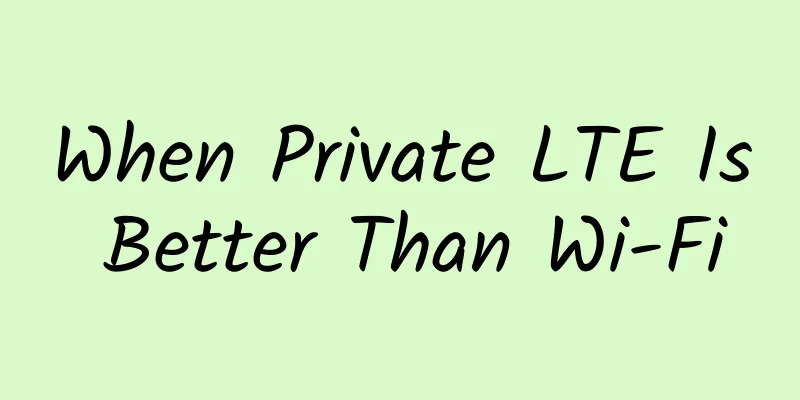When Private LTE Is Better Than Wi-Fi

|
While cellular technology is often thought of as a carrier service, IT organizations can benefit from deploying private LTE technology to complement or even replace Wi-Fi in specific use cases, such as supporting IoT devices that generate large data sets and are deployed over large areas.
What is Private LTE? Private LTE is a local cellular network, including cell sites and core network servers, that is dedicated to supporting the connectivity needs of a specific enterprise without relying on the service provider's cellular network. It enables enterprises to tailor their networks for mission-critical applications, optimize them for low latency, and support specific SLAs – all without interference from the often-congested public wireless spectrum. Private LTE is also suitable for some distributed enterprise use cases, including stadiums, airports, amusement parks, ports, railways, mines, oil/gas extraction, warehouses, factories, agriculture, smart city elements and public safety. Other applications of private LTE involve extremely remote areas with poor cellular coverage. Why might an enterprise need private LTE? Private LTE also competes with public 4G and 5G cellular networks, but it may be a better choice when the large amounts of data being transferred put a strain on public networks in a particular area. The costs of high data volumes on public LTE networks can also be prohibitive. Private LTE can be deployed anywhere, including areas that public operators cannot reach, and data can be saved on-site for security reasons. Private LTE can be optimized to handle traffic types with specific requirements. For example, real-time IoT applications can be guaranteed to have extremely low latency for immediate response. Private LTE is an important alternative to Wi-Fi, especially in situations where Wi-Fi has shortcomings and is best viewed as a complement to Wi-Fi. Private LTE is a good choice when Wi-Fi cannot provide the connectivity required for certain use cases, such as supporting mobile deployments. Wi-Fi is also susceptible to interference from spectrum noise and steel walls. When it is required to provide coverage for large geographic areas, its cost can be prohibitive due to the large number of Wi-Fi access points and the required fiber optic backhaul network. Application Cases With these factors in mind, enterprises can mix and match Wi-Fi and private LTE to provide greater connectivity for complex use cases. Applications for which private LTE is well suited include high-definition video surveillance; remote vehicle, robot and equipment control; mission-critical communications for security teams; and mobile connectivity for public safety vehicles. Private LTE is the best choice to support large numbers of distributed or mobile IoT devices with high data transmission requirements. Acquiring LTE spectrum The spectrum required for private LTE is divided into three categories: public licensed spectrum, shared spectrum, and unlicensed spectrum.
Note: The rules for these options vary by country. Is Private LTE Right for You? Enterprises weighing whether to invest in private LTE should evaluate their network requirements in terms of coverage, number and type of devices, latency and total bandwidth. They should consider whether data will be stored locally or sent to the cloud. What types of devices and applications will need to be connected? Will multiple physical networks be required? Doyle Research expects private LTE (or 5G) to become increasingly popular for complex or mobile enterprise network needs, including sports stadiums, vehicle tracking, digital signage and high-definition cameras. |
<<: How packets travel through the various layers of the TCP/IP protocol stack
>>: 4G network secretly slows down to protect 5G? You really wronged them
Recommend
Why do people take the secondary roads instead of the highways? There are reasons why IPv6 is difficult to popularize
Why take the IPv4 side road when there is the IPv...
3 IT monitoring trends for 2021
The outbreak has put the reliability of websites,...
ZJI: 600 yuan/month-E5-2637v2/16GB/1TB SSD/20M CN2/Hong Kong Kwai Wan Data Center
Last month, ZJI offered a monthly discount for Ho...
Sub-band full-duplex, a compromise for the 5G dream?
Hello everyone, I am Mayfly. In this issue, let’...
2019 NXTWORK Juniper Networks Summit concluded successfully, Juniper Networks and China win together in the multi-cloud era
[51CTO.com original article] On July 11, 2019, Ju...
What do edge computing and 5G mean for the Internet of Things?
Most IoT architectures in the business world are ...
Authoritative release: Ten major events in China's industrial Internet in 2020
In order to comprehensively display the developme...
Don’t be pessimistic: 5G has started quickly, but the power has just begun to show
China’s 5G licenses have only been issued for a y...
Voice message application series——Unlimited message listening assistant
who I am Hello everyone, my name is NGCSS (Next G...
F5 Lin Geng: "Code to User" Application Service Architecture Empowers Enterprise Digital Transformation
Recently, F5, the world's leading multi-cloud...
Nginx's four-layer load balancing (Stream module) configuration based on TCP/UDP ports
HTTP load balancing, which is what we usually cal...
VMISS newly launched Korean VPS with 30% discount, 1G memory package starts from 3.5 Canadian dollars (≈ RMB 18) per month
In May this year, we shared information about VMI...
If VoLTE fails to work well with 5G, it will be a failure
The VoLTE function was once a major feature promo...
10 Useful HTML File Upload Tips
[[351004]] The ability to upload files is a key r...
Is 5G really useful? Please give technology some time
[[393766]] What is 5G network? "5G" act...






![[Mid-Autumn Festival/National Day] CUBECLOUD: 30% off for Lite series/15% off for Pro series, available in CN2 GIA Hong Kong/CN2 GIA Los Angeles](/upload/images/67cabd66b8264.webp)


